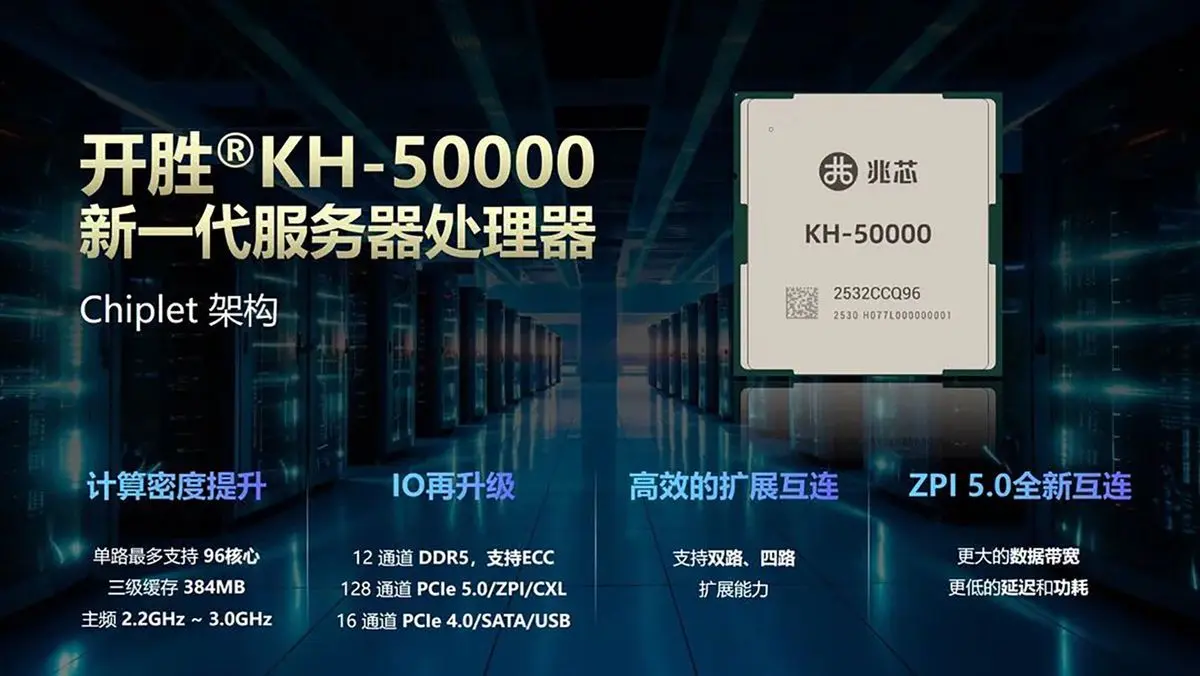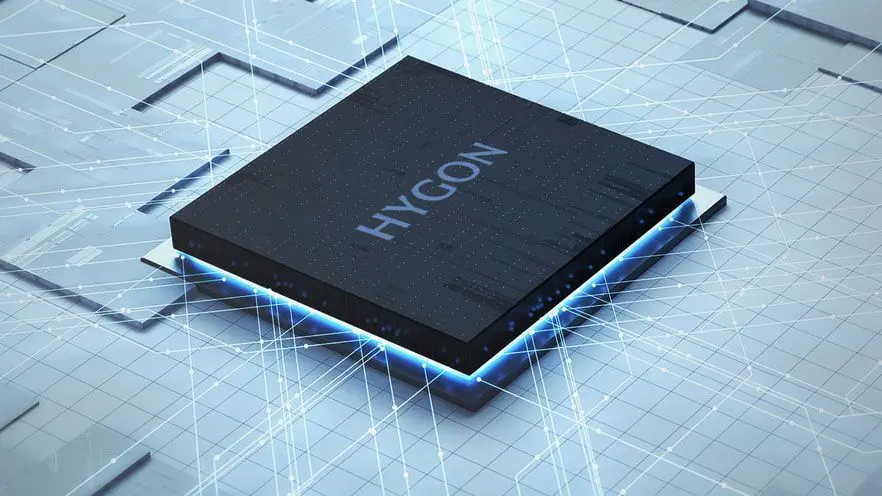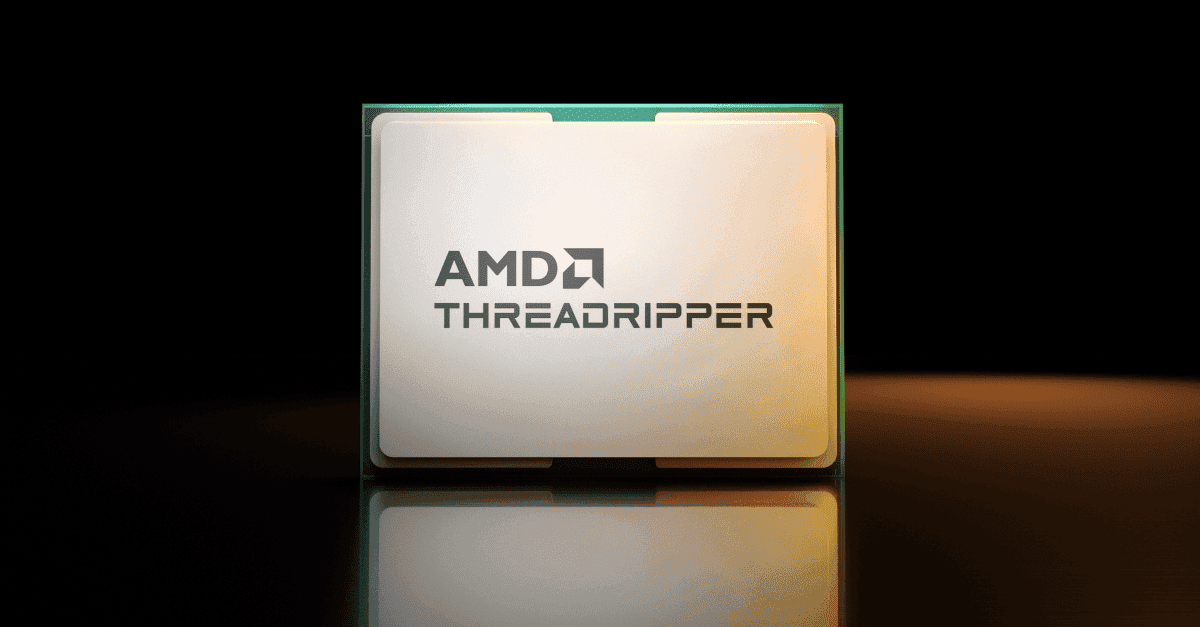Zhaoxin Unveils Advanced AI-Enabled CPUs, Challenging Global Semiconductor Giants
3 Sources
3 Sources
[1]
Chinese CPUs are closing the gap on AMD -- next-gen Zhaoxin chips feature 96 cores, 12-channel DDR5 memory, and 128 PCIe 5.0 Lanes
Zhaoxin, one of China's top fabless semiconductor companies, has announced the company's next-generation KaiXian KX-7000N and Kaisheng KH-50000 processors at the World Artificial Intelligence Conference (WAIC) 2025. The former is a new consumer chip for AI PCs, while the latter is a server chip with specifications that rival AMD's EPYC portfolio. The Kaisheng KH-50000, the successor to the Kaisheng KH-40000, will feature up to 96 cores, aligning with AMD's EPYC 9004 (codenamed Genoa) series. The forthcoming server processors provide three times the number of cores compared to Zhaoxin's current models. Nevertheless, the company has not disclosed whether the Kaisheng KH-50000 will incorporate simultaneous multithreading (SMT) or continue to operate without SMT, as is the case with the Kaisheng KH-40000. While the Kaisheng KH-40000 employs Zhaoxin's Yongfeng architecture, the company has not disclosed which architecture is utilized for the Kaisheng KH-50000. However, considering the significant upgrades in specifications and features, it is reasonable to assume that the Kaisheng KH-50000 adopts a new architecture. Zhaoxin just didn't want to reveal which one yet. In terms of clock speed, Zhaoxin may achieve a range between 2.2 GHz and 3.0 GHz for the Kaisheng KH-50000. This may be higher or lower than the Kaisheng KH-40000, which operates at 2.5 GHz. The increase in core count is also associated with an expansion of the L3 cache. Zhaoxin has officially confirmed that the Kaisheng KH-50000 is equipped with 384MB of L3 cache, a capacity that is six times greater than that of the Kaisheng KH-40000. You may be aware that AMD's Genoa processors include 384MB of L3 cache. Indeed, the Kaisheng KH-50000 could potentially be an identical counterpart to Genoa. Similar to Genoa, the Kaisheng KH-50000 provides 128 PCIe 5.0 lanes and support for 12-channel DDR5 ECC memory, in addition to embracing the Compute Express Link (CXL) interconnect. The Kaisheng KH-50000 supports ZPI (Zhaoxin Processor Interconnect) 5.0, allowing partners to install two or four chips on one motherboard. This enables systems with up to 384 cores. Zhaoxin is riding the AI PC trend. The company revealed the upcoming KaiXian KX-7000N processor at WAIC. This chip is likely based on the KaiXian KX-7000 but features an added NPU for AI tasks, which is probably what the "N" signifies in its name. The KaiXian KX-7000N marks a significant milestone for Zhaoxin, as it is the company's first chip to feature an NPU. Several AI PCs featuring the KaiXian KX-7000N were showcased at the WAIC 2025 event. However, Zhaoxin did not provide detailed specifications for the KX-7000N, only mentioning that it will have more cores and enhanced support for PCIe 5.0, unlike the current KaiXian KX-7000, which is limited to PCIe 4.0. Companies such as Zhaoxin and Lisuan Technology are making significant advances in hardware. Although Chinese-made processors and graphics cards haven't yet challenged industry giants like Intel, AMD, or Nvidia, that remains a future objective. Currently, their focus is on creating reliable products that deliver a decent enough computing experience. Each progress, big or small, moves China closer to achieving technological independence from the West.
[2]
Zhaoxin unveils new consumer and server CPUs aimed at challenging global semiconductor giants
Why it matters: Zhaoxin's latest processors mark a key step in China's push for technological self-reliance, bringing new AI-focused chips that aim to challenge established global players. While still behind industry leaders, these advances reflect growing domestic capabilities in AI computing, signaling a shift toward greater innovation and independence in a strategic sector. This week, Chinese semiconductor company Zhaoxin introduced its latest generation of consumer and enterprise processors at the 2025 World Artificial Intelligence Conference in Shanghai. Two new flagship chips were on display: the KaiXian KX-7000N, aimed at AI-driven personal computers, and the Kaisheng KH-50000, a server processor built to meet rising demand for advanced data center infrastructure. The launch is part of Zhaoxin's effort to reduce China's reliance on foreign technology and strengthen its presence in an industry still dominated by AMD and Intel. Technical details for the KaiXian KX-7000N remain limited, but it marks Zhaoxin's first AI CPU with a dedicated neural processing unit. The KX-7000N builds on the previous KX-7000 consumer chip by adding a high-performance NPU, plus unspecified increases in core count and support for PCI Express 5.0 in place of PCIe 4.0. Tom's Hardware reports that Zhaoxin also unveiled an ecosystem of AI PCs powered by the KX-7000N, aimed at smart content creation, intelligent document writing, education, and more. The company says the chip enables efficient, real-time AI processing at the edge for both enterprise and personal computing. Zhaoxin also showcased the Kaisheng KH-50000 server chip, positioned to compete with AMD's EPYC 9004 Genoa series in core count and platform features. The KH-50000 offers up to 96 physical cores, tripling the count of its predecessor, the KH-40000. Zhaoxin has not confirmed whether the chip supports simultaneous multithreading, but the higher core count should deliver substantial gains in multi-threaded workloads typical of AI training and inference. The new chip integrates 384 MB of L3 cache, matching AMD's latest offerings and outpacing Zhaoxin's previous generation sixfold. It also supports 128 PCIe 5.0 lanes for high-speed data transfer and works with 12-channel DDR5 error-correcting memory to handle the bandwidth demands of AI and data center operations. Compute Express Link support adds flexibility for heterogeneous hardware expansion, an increasingly vital resource as workloads diversify. Zhaoxin's proprietary ZPI 5.0 interconnect enables multi-socket configurations, allowing up to four KH-50000 chips per motherboard for a total of 384 CPU cores. Although Zhaoxin has yet to detail the processor architectures behind its latest chips, the jump in core count and capabilities in the KH-50000 strongly suggests a new design. The company has long relied on its in-house Yongfeng architecture but has not confirmed whether it underpins this generation. The unveiling coincided with demonstrations of complete AI hardware and software solutions created with local partners. These included AI workstations, servers, smart education products, document processing systems, and platforms for government, finance, and healthcare. As China pushes for technological self-sufficiency, Zhaoxin's latest processors show incremental but meaningful progress in challenging global incumbents. Chinese-designed chips have yet to surpass the leading offerings from industry giants, but gains in performance, security, and ecosystem readiness position Zhaoxin as a cornerstone of the country's AI and computing ambitions.
[3]
Zhaoxin Unveils 96-Core Server CPU KH-50000 to Rival AMD EPYC
Zhaoxin, a Chinese chip designer, took the wraps off two new processors at the 2025 World Artificial Intelligence Conference: the Kaisheng KH-50000 aimed squarely at data centers, and the KaiXian KX-7000N designed for AI-enhanced desktop PCs. Both products signal a shift in Zhaoxin's strategy from low-power embedded chips toward higher-performance markets. While details are still emerging, the announced specifications make it clear that Zhaoxin is targeting stiff competition from established players like AMD. Starting with the KH-50000, this server-class CPU jumps from the previous generation's 32 cores to an impressive 96 cores. Clock speeds span from 2.2 GHz at the low end to 3.0 GHz at peak, although it is still unclear whether Zhaoxin has implemented simultaneous multithreading to squeeze extra threads per core. What really stands out is the L3 cache: at 384 MB, it's six times larger than on the KH-40000, which should help with large data sets and multi-threaded workloads. Memory support is also robust, with twelve channels of DDR5 memory featuring error-correcting code. For connectivity, Zhaoxin includes 128 lanes of PCIe 5.0 and compatibility with Compute Express Link, ensuring fast links to accelerators and other peripherals. Perhaps most notably, the KH-50000 supports multi-socket builds via ZPI 5.0 interconnects, so system builders can deploy two- or four-socket servers for up to 384 cores in a single chassis. On the desktop side, the KaiXian KX-7000N is Zhaoxin's first processor to include a dedicated neural processing unit, aimed at running AI inference tasks locally. While the original KX-7000 packed eight cores, the KX-7000N steps up its core count -- though exact figures weren't revealed at the conference. It also transitions from PCIe 4.0 to 5.0, offering higher bandwidth for graphics cards, SSDs, and AI accelerators. Zhaoxin showcased a handful of AI-focused PC demos, hinting at face recognition, real-time video enhancement, and other workload offloads to the NPU. However, the company has yet to share performance benchmarks or power consumption figures, so it's too early to gauge how it stacks up against competitors like Intel and AMD in desktop AI performance. Both processors appear to be built on a new microarchitecture that goes beyond Zhaoxin's existing Yongfeng core design. The company highlighted significant gains in throughput and I/O capabilities, suggesting a redesign at the core level rather than incremental updates. That new architecture should be better suited to high-performance tasks, from cloud workloads to on-device AI inference. There are still open questions about when these chips will hit production, how much power they will draw, and what software ecosystems will support them. Zhaoxin's success in the server segment will depend on developer tools, operating system compatibility, and adoption in enterprise environments. On the consumer side, driver support and NPU programming frameworks will be key to unlocking AI-centric features for gamers and creators.
Share
Share
Copy Link
Chinese chip designer Zhaoxin introduces new server and consumer processors with AI capabilities, aiming to compete with industry leaders like AMD and Intel.
Zhaoxin's Ambitious Leap in Processor Technology
Chinese semiconductor company Zhaoxin has unveiled its latest generation of processors at the 2025 World Artificial Intelligence Conference (WAIC) in Shanghai, marking a significant step in China's push for technological self-reliance. The company introduced two flagship chips: the Kaisheng KH-50000 for servers and the KaiXian KX-7000N for AI-driven personal computers
1
2
.
Source: TechSpot
Kaisheng KH-50000: A Server Powerhouse
The Kaisheng KH-50000 is positioned to compete with AMD's EPYC 9004 (Genoa) series, featuring up to 96 cores - a threefold increase from its predecessor
1
. Key specifications include:- 384MB of L3 cache, six times larger than the previous generation
- Clock speeds ranging from 2.2 GHz to 3.0 GHz
- Support for 128 PCIe 5.0 lanes
- 12-channel DDR5 ECC memory support
- Compute Express Link (CXL) interconnect compatibility
- ZPI (Zhaoxin Processor Interconnect) 5.0 support, allowing for multi-socket configurations with up to 384 cores in a single system
1
3
While the architecture behind the KH-50000 remains undisclosed, the significant upgrades suggest a new design beyond Zhaoxin's existing Yongfeng architecture
1
2
.
Source: Tom's Hardware
KaiXian KX-7000N: AI-Enabled Consumer Chip
The KaiXian KX-7000N represents Zhaoxin's entry into the AI PC market:
- First Zhaoxin chip to feature a dedicated Neural Processing Unit (NPU)
- Increased core count compared to the previous KX-7000 model
- Upgrade to PCIe 5.0 support from PCIe 4.0
- Aimed at smart content creation, intelligent document writing, and education applications
1
2
Related Stories
Implications for the Semiconductor Industry
Zhaoxin's latest offerings signify China's growing capabilities in AI computing and semiconductor design:
-
Technological Independence: These processors are part of China's effort to reduce reliance on foreign technology in critical sectors
2
. -
Competitive Positioning: While still behind industry leaders, Zhaoxin is closing the gap in terms of core count, memory support, and AI capabilities
1
2
3
. -
Ecosystem Development: Zhaoxin showcased AI PCs and complete hardware-software solutions created with local partners, indicating a focus on building a comprehensive ecosystem
2
.
Challenges and Future Prospects
Despite the advancements, Zhaoxin faces several challenges:
- Performance Benchmarks: Detailed performance and power consumption figures are yet to be released, making it difficult to gauge real-world competitiveness
3
. - Software Ecosystem: Success in both server and consumer segments will depend on developer tools, operating system compatibility, and enterprise adoption
3
. - Production Timeline: The timeline for mass production and market availability of these new processors remains unclear
3
.
As China pushes for technological self-sufficiency, Zhaoxin's latest processors demonstrate meaningful progress in challenging global incumbents. While they may not yet surpass leading offerings from industry giants, these advancements position Zhaoxin as a key player in China's AI and computing ambitions
2
.References
Summarized by
Navi
[1]
[2]
Related Stories
Recent Highlights
1
Google launches Gemini 3 Flash as default AI model, delivering speed with Pro-grade reasoning
Technology

2
OpenAI launches GPT Image 1.5 as AI image generator war with Google intensifies
Technology

3
OpenAI launches ChatGPT app store, opening doors for third-party developers to build AI-powered apps
Technology








